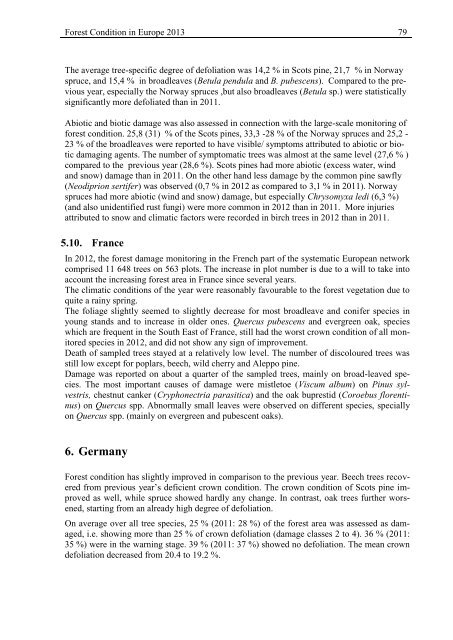Forest Condition in Europe - ICP Forests
Forest Condition in Europe - ICP Forests
Forest Condition in Europe - ICP Forests
Create successful ePaper yourself
Turn your PDF publications into a flip-book with our unique Google optimized e-Paper software.
<strong>Forest</strong> <strong>Condition</strong> <strong>in</strong> <strong>Europe</strong> 2013 79<br />
The average tree-specific degree of defoliation was 14,2 % <strong>in</strong> Scots p<strong>in</strong>e, 21,7 % <strong>in</strong> Norway<br />
spruce, and 15,4 % <strong>in</strong> broadleaves (Betula pendula and B. pubescens). Compared to the previous<br />
year, especially the Norway spruces ,but also broadleaves (Betula sp.) were statistically<br />
significantly more defoliated than <strong>in</strong> 2011.<br />
Abiotic and biotic damage was also assessed <strong>in</strong> connection with the large-scale monitor<strong>in</strong>g of<br />
forest condition. 25,8 (31) % of the Scots p<strong>in</strong>es, 33,3 -28 % of the Norway spruces and 25,2 -<br />
23 % of the broadleaves were reported to have visible/ symptoms attributed to abiotic or biotic<br />
damag<strong>in</strong>g agents. The number of symptomatic trees was almost at the same level (27,6 % )<br />
compared to the previous year (28,6 %). Scots p<strong>in</strong>es had more abiotic (excess water, w<strong>in</strong>d<br />
and snow) damage than <strong>in</strong> 2011. On the other hand less damage by the common p<strong>in</strong>e sawfly<br />
(Neodiprion sertifer) was observed (0,7 % <strong>in</strong> 2012 as compared to 3,1 % <strong>in</strong> 2011). Norway<br />
spruces had more abiotic (w<strong>in</strong>d and snow) damage, but especially Chrysomyxa ledi (6,3 %)<br />
(and also unidentified rust fungi) were more common <strong>in</strong> 2012 than <strong>in</strong> 2011. More <strong>in</strong>juries<br />
attributed to snow and climatic factors were recorded <strong>in</strong> birch trees <strong>in</strong> 2012 than <strong>in</strong> 2011.<br />
5.10. France<br />
In 2012, the forest damage monitor<strong>in</strong>g <strong>in</strong> the French part of the systematic <strong>Europe</strong>an network<br />
comprised 11 648 trees on 563 plots. The <strong>in</strong>crease <strong>in</strong> plot number is due to a will to take <strong>in</strong>to<br />
account the <strong>in</strong>creas<strong>in</strong>g forest area <strong>in</strong> France s<strong>in</strong>ce several years.<br />
The climatic conditions of the year were reasonably favourable to the forest vegetation due to<br />
quite a ra<strong>in</strong>y spr<strong>in</strong>g.<br />
The foliage slightly seemed to slightly decrease for most broadleave and conifer species <strong>in</strong><br />
young stands and to <strong>in</strong>crease <strong>in</strong> older ones. Quercus pubescens and evergreen oak, species<br />
which are frequent <strong>in</strong> the South East of France, still had the worst crown condition of all monitored<br />
species <strong>in</strong> 2012, and did not show any sign of improvement.<br />
Death of sampled trees stayed at a relatively low level. The number of discoloured trees was<br />
still low except for poplars, beech, wild cherry and Aleppo p<strong>in</strong>e.<br />
Damage was reported on about a quarter of the sampled trees, ma<strong>in</strong>ly on broad-leaved species.<br />
The most important causes of damage were mistletoe (Viscum album) on P<strong>in</strong>us sylvestris,<br />
chestnut canker (Cryphonectria parasitica) and the oak buprestid (Coroebus florent<strong>in</strong>us)<br />
on Quercus spp. Abnormally small leaves were observed on different species, specially<br />
on Quercus spp. (ma<strong>in</strong>ly on evergreen and pubescent oaks).<br />
6. Germany<br />
<strong>Forest</strong> condition has slightly improved <strong>in</strong> comparison to the previous year. Beech trees recovered<br />
from previous year’s deficient crown condition. The crown condition of Scots p<strong>in</strong>e improved<br />
as well, while spruce showed hardly any change. In contrast, oak trees further worsened,<br />
start<strong>in</strong>g from an already high degree of defoliation.<br />
On average over all tree species, 25 % (2011: 28 %) of the forest area was assessed as damaged,<br />
i.e. show<strong>in</strong>g more than 25 % of crown defoliation (damage classes 2 to 4). 36 % (2011:<br />
35 %) were <strong>in</strong> the warn<strong>in</strong>g stage. 39 % (2011: 37 %) showed no defoliation. The mean crown<br />
defoliation decreased from 20.4 to 19.2 %.
















